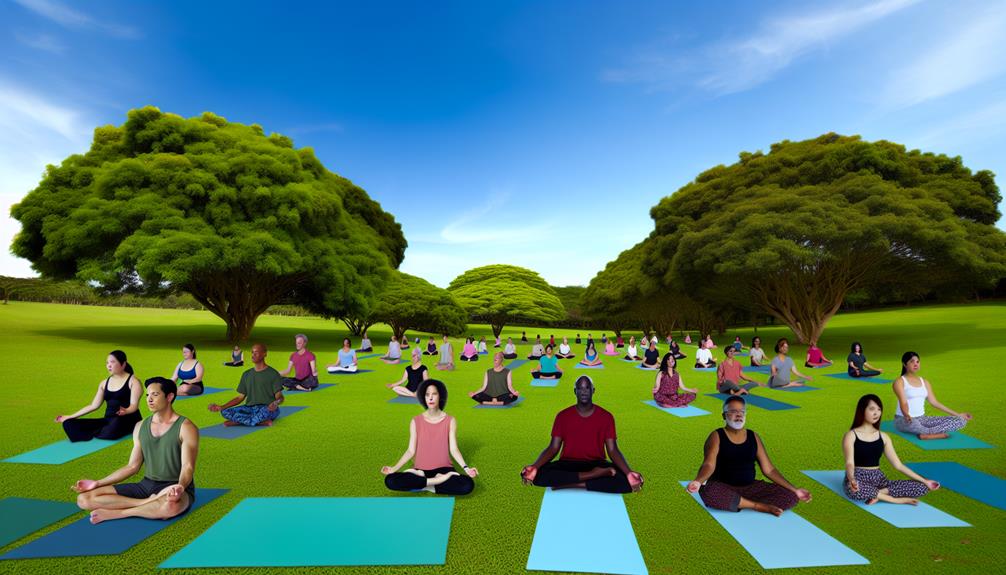To flush out detox toxins safely, incorporate low-impact exercises into your routine. Activities like walking, tai chi, and swimming enhance circulation and support lymphatic flow, facilitating natural detoxification. These exercises not only minimize joint stress but also improve cardiovascular health and mental clarity. Ensuring proper hydration and nutrition alongside these movements enhances their effectiveness. Aim for consistency, engaging in these activities 3-5 times a week, while integrating mindfulness and proper recovery techniques. By doing so, you promote a holistic approach to detoxification. Keep exploring and discover more strategies for improving your detox process.
Key Takeaways
- Engage in low-impact exercises like yoga, swimming, or walking to enhance circulation and support toxin elimination from the body.
- Stay hydrated by drinking plenty of water to facilitate the detoxification process and promote optimal kidney function.
- Incorporate gentle stretching routines to improve flexibility, circulation, and relaxation, aiding in toxin removal and recovery.
- Maintain a consistent workout schedule of 3-5 times a week to maximize detox benefits and support overall physical fitness.
- Focus on mindful movement and breathing techniques during exercises to enhance mental clarity and emotional balance.
Understanding Detoxification

Detoxification is a process that occurs continually in the body, as it works to eliminate toxins and maintain homeostasis. This complex mechanism involves multiple detox pathways, including the liver, kidneys, lungs, and skin, each playing a key role in processing and excreting harmful substances. For example, healthcare services can support individuals in understanding these processes and finding ways to enhance their detoxification efforts, such as through proper nutrition and wellness programs at Syracuse Community Health Center. Cellular detoxification is particularly important, as it allows cells to rid themselves of waste products and environmental toxins, thereby promoting ideal cellular function and health.
The body employs various methods to facilitate detoxification. For instance, the liver metabolizes toxins into less harmful substances, which are then excreted via bile or urine. The kidneys filter blood to remove waste, while the skin helps eliminate toxins through perspiration. Understanding these detox pathways enables individuals to make informed choices that support their body's natural processes.
Incorporating lifestyle practices that enhance detoxification, such as hydration, balanced nutrition, and low-impact exercise, can greatly improve the efficiency of these pathways. Fostering a sense of belonging within a community dedicated to health and wellness can further motivate individuals to embrace detoxification as an essential aspect of their overall well-being.
Benefits of Low-Impact Exercise
While many people associate exercise with high-intensity workouts, low-impact exercise offers a multitude of benefits that can be equally effective for promoting health and well-being. Engaging in such activities fosters a strong mind-body connection, enhancing holistic wellness by integrating physical and mental health. In addition, these exercises can be a great option for those seeking remote work opportunities, as discovering the best sites for remote customer service jobs can allow individuals to manage their time and incorporate exercise into their daily routines.
Low-impact exercises, such as swimming, yoga, and cycling, provide significant cardiovascular health benefits while minimizing stress on the joints. This makes them particularly suitable for individuals seeking joint health, as they can promote muscle recovery and flexibility improvement without the risk of injury associated with high-impact workouts.
In addition, these forms of exercise are known for their ability to provide stress relief, allowing participants to unwind and connect with their bodies. Regular practice can lead to mood enhancement, delivering an energy boost that invigorates daily life. Moreover, low-impact exercise contributes to mental clarity, enhancing focus and cognitive function.
Incorporating low-impact workouts into your routine not only supports physical fitness but also nurtures emotional well-being, creating a balanced lifestyle where individuals feel a sense of belonging and community. Embrace the myriad benefits of low-impact exercise and discover a fulfilling path to wellness.
Key Principles of Safe Detox

Understanding the key principles of safe detox is essential for anyone looking to enhance their health without compromising well-being. Many detox myths can lead to harmful practices, so it is vital to adopt safe and effective methods. Here are some foundational principles to reflect on:
- Holistic approaches: Embrace detox as a thorough lifestyle change, not a quick fix. Engaging in activities that promote long-term wellness, like playing OVO Unblocked Games, can also support your mental health during the detox process.
- Nutrition focus: Prioritize whole foods that support your body's natural detoxification processes.
- Hydration importance: Drink plenty of water to help flush toxins and improve overall health.
- Mindful movement: Engage in low-impact exercises that promote circulation and encourage toxin elimination.
- Rest and recovery: Allow time for your body to recuperate, as effective detox requires adequate rest.
Additionally, reflect on emotional detox strategies to address toxin sources beyond physical elements. Utilize natural remedies and maintain a balanced perspective on detoxification. By following these safe practices, you can foster a supportive environment for your body's natural healing processes, ensuring that your detox journey is both effective and nurturing.
Types of Low-Impact Exercises
Incorporating low-impact exercises into your detox regimen can greatly enhance your body's ability to eliminate toxins while minimizing strain on your joints and muscles. These exercises not only promote physical wellness but also foster a sense of community and belonging among participants. Just as P. Diddy's influence in music and fashion showcases the importance of creativity and expression, low-impact activities allow individuals to explore their own fitness journeys in a supportive environment.
Chair exercises are excellent for those seeking to improve strength and flexibility without excess stress. Aquatic aerobics offers a buoyant environment, making it ideal for joint protection while providing a full-body workout. Tai chi, characterized by its slow, flowing movements, encourages mindful movement and reduces stress, further aiding detoxification.
Pilates routines focus on core strength and stability, utilizing resistance bands to enhance muscle engagement without high impact. Incorporating balance exercises can improve coordination and prevent falls, making them suitable for all fitness levels. For those looking for a gentle approach to cardiovascular health, gentle jogging allows for low-impact endurance building while still promoting circulation.
Collectively, these low-impact options provide a diverse range of benefits, empowering individuals to choose activities that resonate with their personal fitness journey, ultimately supporting their detox goals.
Yoga for Detoxification

Yoga serves as a powerful tool for detoxification, offering a holistic approach that combines physical movement, breath control, and mindfulness. In recent years, many have turned to practices like yoga to support their health journeys, especially notable figures such as Bruce Willis, who have focused on holistic well-being during challenging times an Insight Into His Health Journey. Through various yoga poses and cleansing flows, practitioners can stimulate the body's natural detoxification processes, enhancing overall well-being.
- Gentle stretches that promote circulation and lymphatic drainage
- Breathing techniques designed to increase oxygen intake and release toxins
- Detox sequences tailored to support digestive health and stimulate internal organs
- Restorative practices that encourage relaxation and reduce stress
- Meditation benefits that foster mental clarity and emotional balance
Engaging in mindful movement allows for deeper chakra alignment, promoting energy balance within the body. This alignment encourages the release of stagnant energy, further supporting detoxification. Incorporating these elements into your routine not only uplifts your physical state but also nourishes your mental and emotional health. Whether you are new to yoga or an experienced practitioner, these tools can create a sense of belonging within a community that values holistic wellness. Embrace yoga as a pathway to rejuvenation, and experience the transformative effects of consistent practice on your detox journey.
Swimming as a Detox Method
While many may associate swimming primarily with recreation, it also serves as an effective method for detoxification. Engaging in this low-impact exercise promotes circulation, which is essential for flushing out toxins from the body. The rhythmic nature of swimming encourages the release of endorphins, enhancing mood and overall well-being.
Optimal water temperature plays a vital role in maximizing the detox benefits of swimming. Warm water can help to relax muscles and stimulate blood flow, while cooler temperatures invigorate and refresh, promoting alertness. Finding a comfortable balance allows for prolonged sessions that facilitate deeper detoxification.
Incorporating proper breathing techniques during swimming is equally important. Controlled inhalation and exhalation not only improve lung capacity but also enhance oxygen delivery to the body's tissues. This increase in oxygen facilitates the removal of carbon dioxide and other metabolic waste, further supporting the detox process.
Walking: The Simple Solution

Walking is a highly accessible form of exercise that offers numerous benefits for detoxification. Regular walking can enhance circulation, promote lymphatic drainage, and support overall metabolic health, making it an effective strategy for flushing out toxins. In this section, we will explore practical tips for maximizing your walking routine and ways to seamlessly incorporate it into your daily life.
Benefits of Walking
Engaging in regular walking offers a myriad of health benefits that extend beyond mere physical activity. This simple yet powerful exercise can profoundly impact both physical and mental well-being, making it an ideal choice for individuals seeking to enhance their overall health. Here are some remarkable walking benefits:
- Improved cardiovascular health: Walking strengthens the heart and improves circulation.
- Enhanced mental clarity: Regular walking promotes cognitive function and can help alleviate symptoms of anxiety and depression.
- Weight management: As a low-impact exercise, walking aids in burning calories and maintaining a healthy weight.
- Better joint health: Walking increases flexibility and reduces the risk of joint-related issues.
- Social connections: Walking can be a communal activity, fostering relationships and a sense of belonging.
Incorporating walking into your daily routine not only provides physical benefits but also enhances mental clarity, allowing for a more focused and productive mindset. By embracing this accessible form of exercise, individuals can cultivate a healthier lifestyle while connecting with their surroundings and community. Walking is more than just a form of exercise; it is a pathway to holistic well-being.
Tips for Effective Walking
To maximize the benefits of walking, implementing effective strategies can greatly enhance your experience and outcomes. Utilizing proper walking techniques is essential. Start by maintaining an upright posture, engaging your core, and allowing your arms to swing naturally. This alignment not only promotes efficiency but also reduces the risk of injury.
Incorporating mindful walking can further elevate your practice. This involves being fully present during your walk, focusing on your breath, the rhythm of your steps, and the environment around you. This awareness can transform a simple stroll into a meditative experience, fostering a deeper connection with your body and nature.
Consider varying your walking pace and terrain to challenge your muscles and cardiovascular system. Introducing intervals of brisk walking can enhance your heart health and boost calorie burn. Additionally, aim for at least 30 minutes of walking most days, which research shows yields significant health benefits.
Lastly, walking in groups or with a partner can foster a sense of community, making the experience more enjoyable and motivating. By integrating these tips, you can create a walking routine that not only supports detoxification but also enriches your overall well-being.
Incorporating Walking Into Routine
Incorporating walking into your daily routine can serve as a straightforward yet powerful solution for enhancing physical and mental well-being. This low-impact exercise offers a multitude of walking benefits, including improved cardiovascular health, reduced stress, and increased energy levels. To successfully integrate walking into your life, consider these key elements:
- Walking routes: Explore diverse areas in your neighborhood or local parks to keep your walks interesting.
- Walking techniques: Focus on posture and pace to maximize benefits and reduce injury risks.
- Walking safety: Always prioritize safety by wearing appropriate gear and choosing well-lit paths.
- Walking motivation: Set achievable goals and track your progress to maintain enthusiasm.
- Walking mindfulness: Use your walking time as a moment for reflection or meditation, enhancing mental clarity.
Aim for a walking duration of at least 30 minutes, with a frequency of five days a week to reap the full benefits. Becoming part of a walking community can further boost your motivation and help you stay consistent. Ultimately, making walking a regular part of your routine fosters a sense of belonging and connection to others who share your commitment to health.
Cycling for Gentle Toxin Release
Cycling is an effective and low-impact exercise that promotes the gentle release of toxins while enhancing cardiovascular health. This activity stimulates circulation and lymphatic flow, aiding in the body's natural detoxification processes. To maximize the benefits, incorporating specific tips for effective cycling can help optimize toxin removal and overall well-being.
Benefits of Cycling
The rhythmic motion of pedaling not only invigorates the body but also serves as a gentle catalyst for toxin release. Engaging in cycling, whether through mountain biking on rugged trails or urban cycling in city environments, provides myriad health benefits while fostering a sense of community among riders.
- Enhances cardiovascular health
- Promotes mental well-being through endorphin release
- Supports weight management and muscle toning
- Strengthens the cycling community through shared experiences
- Encourages a sustainable lifestyle with reduced carbon footprint
Tips for Effective Cycling
Effective cycling requires a thoughtful approach to maximize both enjoyment and the gentle release of toxins from the body. To achieve this, cyclists should focus on specific cycling techniques that promote a steady and moderate pace, thereby enhancing circulation and lymphatic flow. Aim for rides that last at least 30 minutes, allowing your body to gradually warm up and engage in a rhythm that encourages detoxification.
In addition to pacing, maintaining bike safety is paramount. Always wear a properly fitted helmet and confirm your bike is in excellent working condition. Regularly check brakes, tires, and gears to prevent accidents and confirm a smooth ride.
Incorporating varied terrains, such as gentle hills or scenic paths, can also enrich your experience while providing a low-impact workout. Remember to stay hydrated and listen to your body; if you feel fatigued, it's okay to slow down or take breaks.
Cycling with friends or joining a local cycling group can enhance motivation and foster a sense of community. By employing these strategies, you can enjoy effective cycling that not only promotes physical health but also contributes to a holistic detox experience.
Incorporating Stretching Routines

Incorporating stretching routines into your exercise regimen is essential for enhancing flexibility and promoting overall well-being. Stretching not only improves range of motion but also plays a significant role in muscle recovery, allowing your body to effectively flush out detox toxins. By integrating both dynamic and static stretches, you can maximize the benefits of your workouts.
- Dynamic stretches prepare the body for activity and reduce injury risk.
- Static stretches help improve flexibility benefits post-workout, promoting relaxation and recovery.
- Breathing techniques enhance your stretching routine, fostering mindfulness and deeper muscle relaxation.
- Injury prevention is a noteworthy advantage, as targeted stretching strengthens muscles and joints.
- Improved circulation aids in toxin removal, supporting overall health.
Engaging in a regular stretching routine fosters a sense of belonging within the fitness community, as many individuals share the goal of enhancing their physical capabilities. By prioritizing stretching, you not only contribute to your personal health journey but also connect with others who value the importance of a well-rounded exercise program. Embrace stretching as a significant component of your detoxification process and enjoy its numerous physical and mental benefits.
Creating a Balanced Exercise Plan
When designing a balanced exercise plan, it is essential to contemplate various components that collectively contribute to ideal health and detoxification. A well-rounded regimen should include diverse workout variety, ensuring that you engage different muscle groups and prevent boredom. Aim for a consistent exercise frequency, ideally three to five times a week, to promote steady detoxification and overall fitness.
Goal setting is important; establish specific, measurable objectives to keep motivation high. Tracking progress can further enhance your commitment, allowing you to celebrate milestones and adjust your plan as needed.
Incorporating recovery techniques, such as stretching and adequate rest, is critical for injury prevention and enhancing performance. Choose equipment that fits your comfort and skill level, and consider environmental factors like space and accessibility to create a sustainable routine.
Frequently Asked Questions
Can Detoxification Help With Weight Loss?
Detoxification can indeed support weight loss, primarily through various detox methods that promote metabolic efficiency. Engaging in specific exercise types, such as aerobic activities and strength training, can enhance the body's natural detox processes. These approaches not only facilitate the elimination of toxins but also encourage healthier lifestyle choices, reinforcing a sense of community and shared goals among individuals pursuing weight loss. Ultimately, an extensive detox strategy can yield significant benefits for overall well-being.
How Often Should I Exercise for Detox Benefits?
To achieve detox benefits, the recommended exercise frequency typically ranges from three to five times per week. It is essential to contemplate exercise intensity; low-impact workouts, such as yoga or walking, can be particularly effective for promoting detoxification while minimizing strain on the body. Consistent participation in these activities not only aids in toxin removal but also fosters a sense of community and belonging among participants, enhancing overall well-being.
Are There Any Risks to Detox Through Exercise?
Detox methods involving exercise can offer health benefits, but they also carry potential risks. Over-exercising or engaging in high-intensity workouts without proper conditioning may lead to injuries, dehydration, or fatigue. It is crucial to prioritize exercise safety by choosing appropriate activities and listening to your body. Incorporating low-impact exercises can mitigate risks while still promoting detoxification. Consulting a healthcare professional before starting any detox regimen is advisable to guarantee an individualized and safe approach.
What Should I Eat Before Exercising for Detox?
To optimize your exercise routine for detoxification, consider incorporating pre-workout snacks that are rich in complex carbohydrates and protein, such as whole grain toast with nut butter or a banana with yogurt. Additionally, focus on hydration strategies by consuming water or electrolyte-rich beverages to maintain fluid balance and support metabolic processes. These nutritional choices will enhance energy levels, improve performance, and promote overall well-being, fostering a sense of community among those engaged in health-focused activities.
How Can I Track My Detox Progress Effectively?
Tracking detox progress effectively involves a structured approach such as detox journaling. This practice enables individuals to document daily experiences, mood variations, and physical changes, creating a thorough overview of their journey. Establishing progress milestones, such as improved energy levels or clearer skin, can further motivate and provide tangible evidence of success. Engaging in this reflective process fosters a sense of community, as sharing insights can encourage and support others on similar paths.

